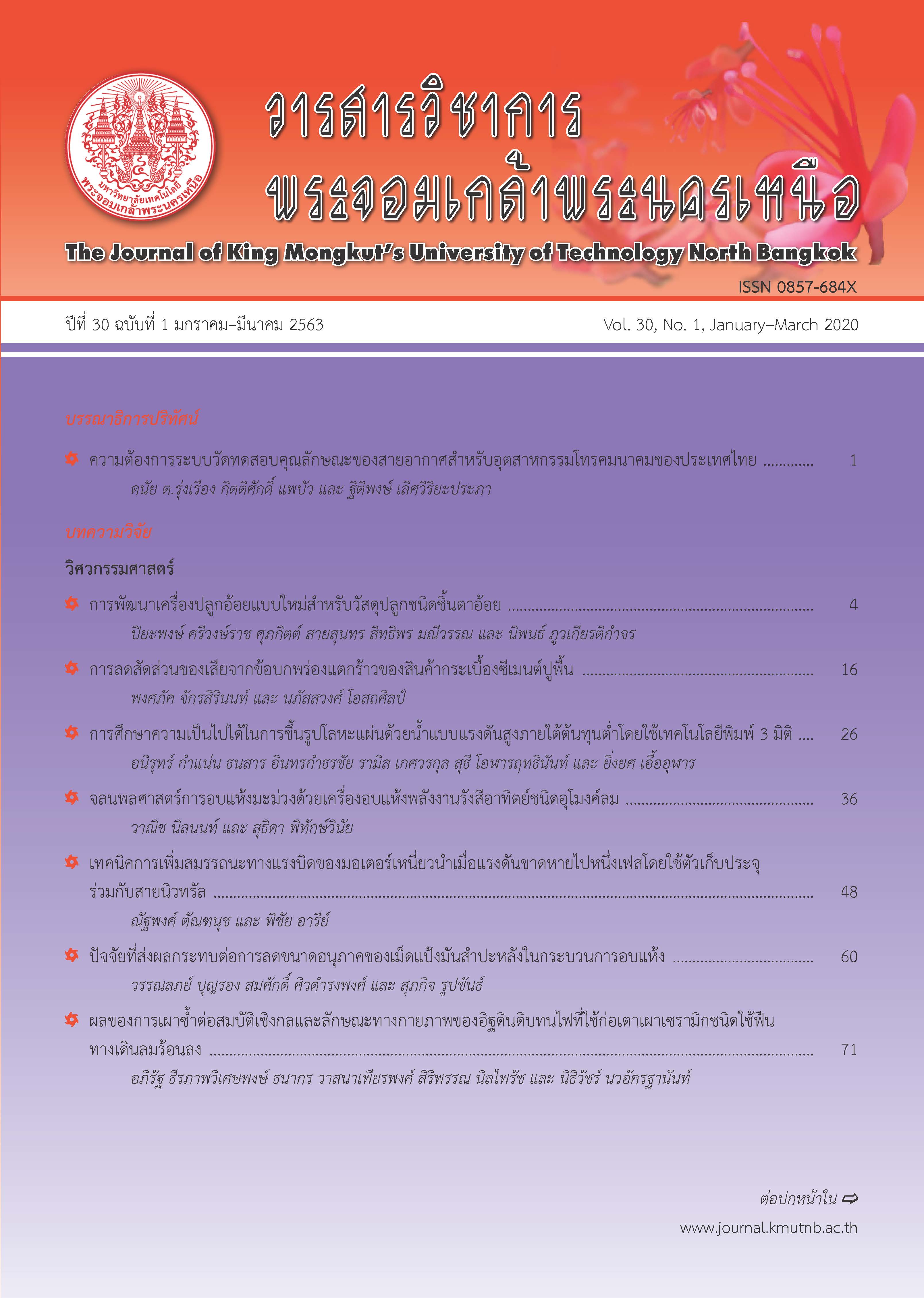Parameters Affecting Particle Size Reduction of Tapioca Starch in Drying Process
Main Article Content
Abstract
In 2018, Thailand exported 3.1 million tons of native tapioca starch, worth 1,037.0 million US dollars. And modified tapioca starch, 1.0 million tons, worth 617.8 million US dollars. And forecast the export value will increase every year. Therefore, reducing the particle size of tapioca starch helps increase tapped bulk density. It can increase the weight with the same size packaging bag resulting in higher transportation volumes which will help save on export costs. The objective of this research was to determine the parameter that affects to a particle size reduction of tapioca starch. Involved with design, fabrication and installation on factory to produce tapioca starch. For the test method, the flow of air through with reducing machine is constant of 60,000 m3 h–1. Which are consisted of five parameters; type of tapioca starch, feed rate, moisture of material, type of blade and tip speed of blade. In addition, this machine was installed on drying process. The test material used as native tapioca starch and modified tapioca starch. The energy was measured by kilowatt-hour meter. A bulk density to analysis with tapped bulk density equipment and analysis of particle size with a sieve analyzer. This research was conducted under a factorial design, which is the most commonly used method for screening the primary and the combined effect of each factor. It was found that the strongest main factor influence a particle size reduction was the type of blade, followed by tip speed of blade, type of tapioca starch, the moisture of material and feed rate respectively. It was found that a particle size of native tapioca starch after through from reducing machine with flat blade type, particle size cut off on D80 were decrease from 61.90 micron to 54.71 micron and on D50 were decrease from 53.21 micron to 41.82 micron and the tapped bulk density increased from 575.12 to 720.54 kg m–3. And modified tapioca starch was found particle size cut off on D80 were decrease from 56.77 micron to 49.92 micron and on D50 were decrease from 42.26 micron to 37.54 micron and the tapped bulk density increased from 575.14 to 703.70 kg m–3. On the energy consumption was found that tip speed has to significant influence followed by type of blade, type of tapioca starch, feed rate and moisture of material respectively. And the energy index for native tapioca starch was 9.52–12.92 kWh ton–1 and modified tapioca starch was 9.22–12.52 kWh ton–1.
Article Details
The articles published are the opinion of the author only. The author is responsible for any legal consequences. That may arise from that article.
References
[2] C. Chuasuwan. (2017, August). Business and industry trends for tapioca starch of year 2018-2020. Bank of Ayudhya Public Company Limited. Bangkok, Thailand [Online]. Available: https://www.krungsri.com
[3] P. Fellows, Food Processing Technology. 2nd ed., Woodhead Publishing Limited. 2000, pp. 98–116.
[4] A. D. Srikanth. Tangirala, K. Charithkumar, and T. K. Goswami, “Modeling of size reduction, Particle size analysis and flow characterization of spice powders ground in hammer and pin mills,” International Journal of Research in Engineering and Technology, vol. 1, no. 12, pp. 296–300, 2014.
[5] M. D. Torres, R. Moreira, F. Chenlo, M. H. Morel, and C. Barron, “Physicochemical and structural properties of starch isolated from fresh and dried chestnuts and chestnut flour properties of chestnut starch,” Food Technology and Biotechnology, vol. 52, no. 1, pp. 135–139, 2014.
[6] L. Vogel and W. Peukert, “From single particle impact behaviour to modelling of impact mills,” Chemical Engineering Science, vol. 60, no. 18, pp. 5164–5176, 2005.
[7] L. Wang, P. Wang, A. S. M. Saleh, Q. Yang, Y. Ge, N. Wang, S. Yang, and Z. Xiao, “Influence of fluidized bed jet milling on structural and functional properties of normal maize starch,” Starch - Stärke, vol. 70, no. 11–12, pp. 1–11, 2018.
[8] E. Li, S. Dhital and J. Hasjim, “Effects of grain milling on starch structures and flour/starch properties,” Starch - Stärke, vol. 66, no. 1–2, pp. 1–10, 2014.
[9] Advances in Potato Chemistry and Technology, 1st ed., 2009 Elsevier Inc., 2009, pp. 273–318.

